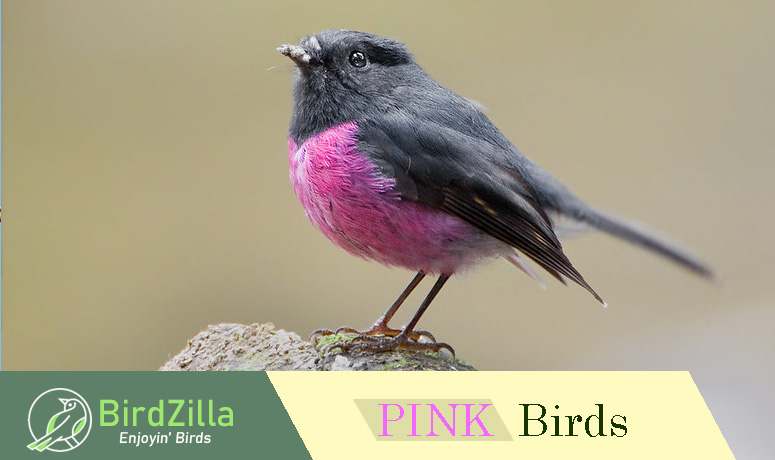
Pink birds are often associated with tropical climates, which is not the primary climate in the U.S. But this isn’t necessarily the case.
In most of North America, pink birds are considered a rarity. However, pink birds inhabit many different areas in the United States.
Several species of birds with pink feathers can be seen in these areas with mild summers and cold winters.
We’ve compiled a list of the most common pink birds! Some of these birds may be primarily pink, while others may only have sections of pink.
You decide.
On this page
#12 Roseate Spoonbill
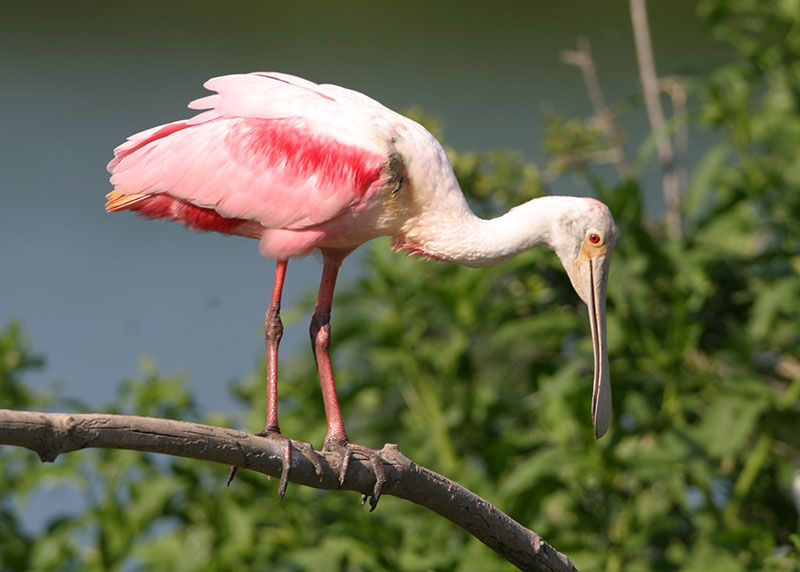
Roseate Spoonbill
Rosate Spoonbills are medium-sized wading birds, named after their distinctive interesting bills and beautiful light pink plumage.
These birds forage in shallow marine, brackish, and fresh waters with abundant aquatic invertebrates. These habitats include mangroves, bays, roadside ditches, and forested swamps. These spoonbills roost and nest in shrubs and trees along the edge of the water.
Like other pinkish-orange birds, Roseate Spoonbills get their coloration from their diet. Aquatic vertebrates, like crustaceans, contain pigments called carotenoids that turn their feathers pink.
#11 American Flamingo
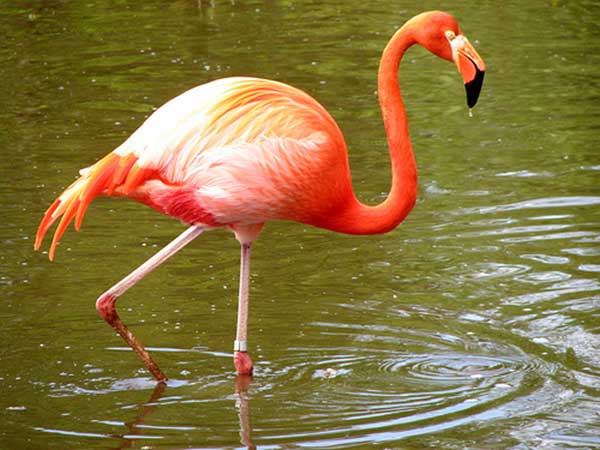
The American Flamingo is one of the most recognizable pink birds in the United States. In fact, it’s the only species of Flamingo that’s native to North America.
American Flamingos are large flamingos, closely related to Chilean and Greater Flamingos. Additionally, it has the longest legs in proportion to its body of all birds.
Their plumage can range in color from pink to orange to red; however, it’s usually a deep pink. American Flamingos can be found in the Florida Keys, Southern Florida, the Caribbean, and the northern coast of South America in coastal pools of water and shallow swamps.
#10 Anna’s Hummingbird
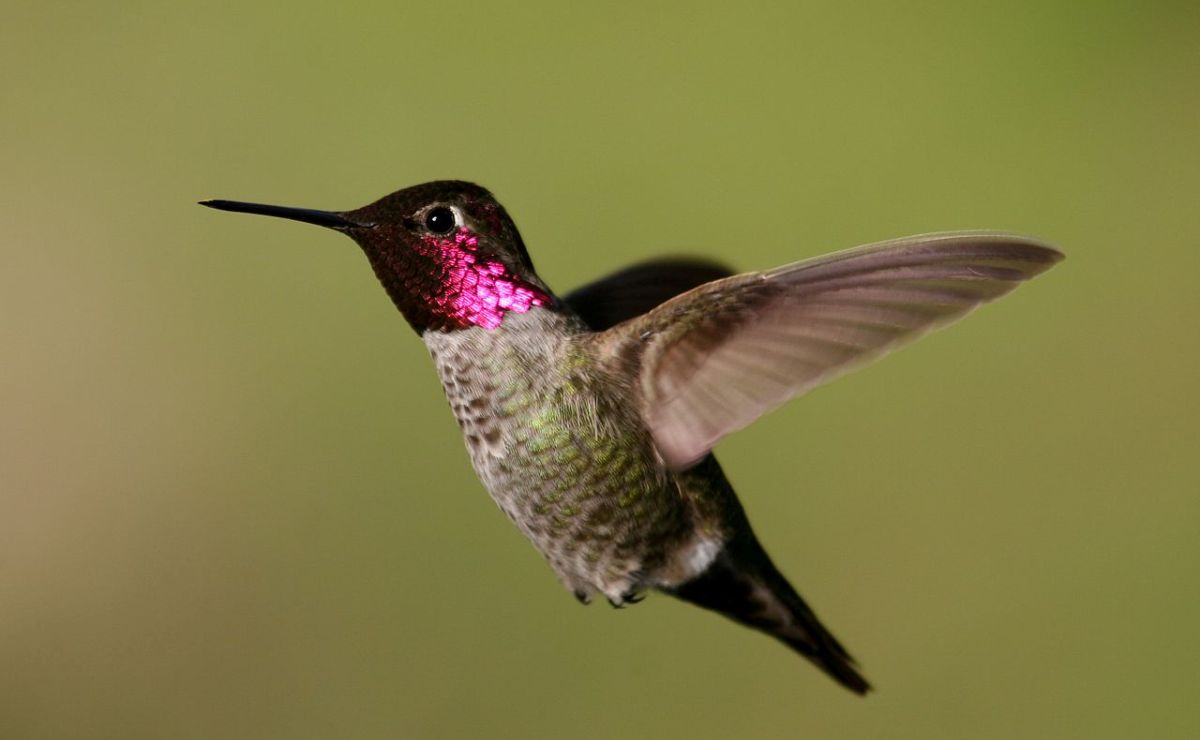
Anna’s Hummingbirds are stocky, medium-sized hummingbirds with some pink. They have shorter, straight bills and relatively broad tails. They’re one of the most common hummingbirds on the Pacific Coast.
However, there’s nothing ordinary about their appearance. Their sparkling rose-pink throats and bright emerald-green bodies make them look like flying jewels instead of birds.
Read more: How do hummingbirds get their colors?
They’re no heavier than a nickel and not much larger than a ping-pong ball. They can be found along the western coast of the United States, Southern Canada, and Northern Mexico.
#9 Scarlet Ibis
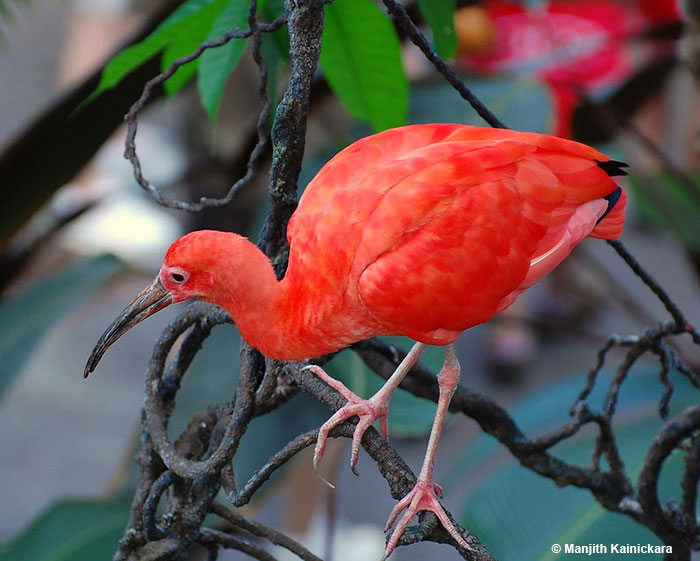
© Manjith Kainickara
The Scarlet Ibis is a medium-sized wading bird with long legs and a curved bill. The bill changes color throughout the year. Scarlet Ibis get their name from their gorgeous scarlet color. You’ll see various shades and tints of the scarlet color throughout their feathers. The wing tips are usually an inky black, but they can sometimes be dark blue as well.
Scarlet Ibises can be found throughout the Caribbean islands and South America. Native flocks exist in Colombia, Brazil, Guyana, French Guiana, Venezuela, Suriname, Trinidad and Tobago, and the islands of the Netherlands Antilles.
Scarlet Ibises inhabit wetlands, mudflats, freshwater lakes, rainforests, and mangroves.
#8 Pink Cockatoo
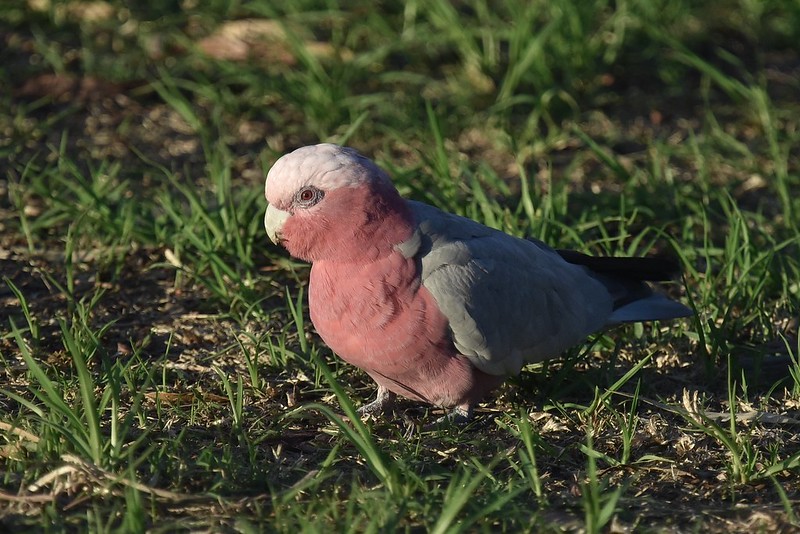
© Jean and Fred Hort @ Flickr
The Pink Cockatoo are relatively small cockatoos. They’re also commonly known as the Major Mitchell’s Cockatoo. They’re 35 to 40 centimeters long, but their small size means nothing due to their distinctive red and white head and pink coloring.
The pink patches are on their neck, face, under wings, and breast. This magnificent color can be seen clearly when their wings are fully spread out, so when they’re landing and flying.
Pink Cockatoosare found in Australia, they live in central NSW, the northern and southern portions of inland Western Australia, and southwest Queensland.
Pink Cockatoos move around a lot; they prefer habitats that have an abundance of food and water. You have the best chance of finding them in inland semi-arid or arid areas, such as timbered grasslands, open woodland, mulga, casuarina, mallee, and Callitris country.
#7 Bourke’s Parakeet
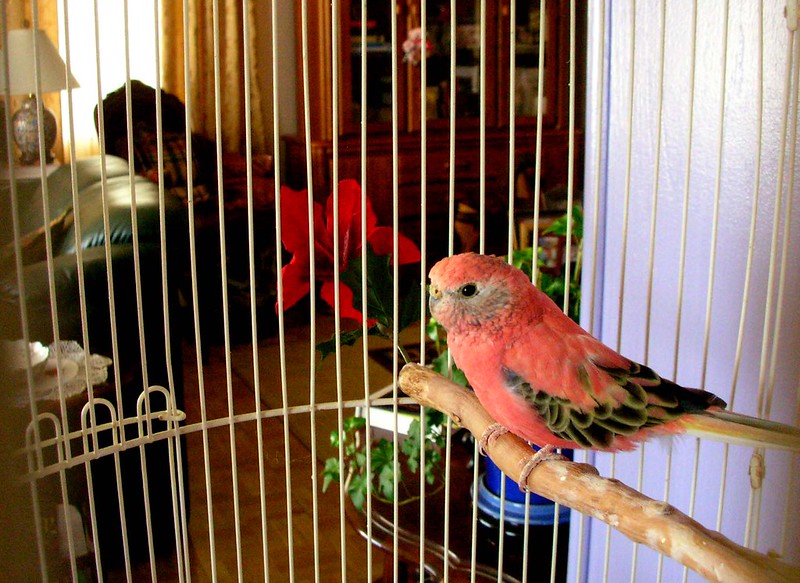
© Zeetz Jones @ Flickr
The Bourkes Parakeet is native to Central and Southwestern Australia. Additionally, they’re an endangered species.
They’re average-sized Parakeets and are primarily brown, have pinkish breasts, pink abdomens, and blue rumps. Their legs are dark-brown, they have zygodactyl toes, and bills that are yellowish-brown.
Related: How Long Do Parakeets Live?
Males and females can be distinguished just by looking at them; adult females have entirely grey heads and adult males have bluish-brown crowns.
#6 Pine Grosbeak
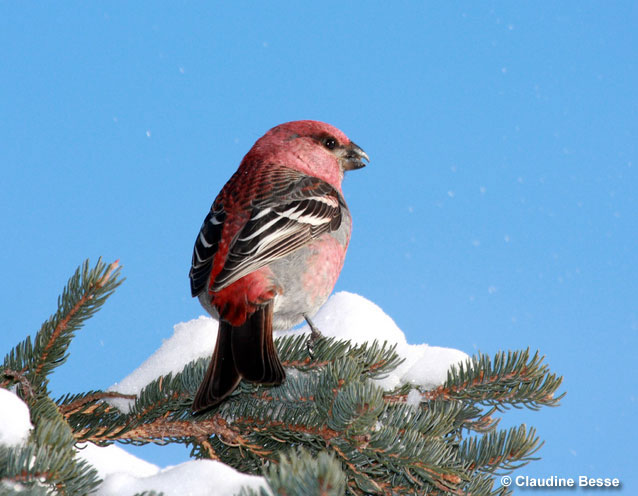
The Pine Grosbeak is a large, heavy-chested finch. They have round heads, conical, thick bills, and a slightly notched, long tail. They’re robin-sized.
Male Pine Grosbeaks are gray and reddish-pink. Female Pine Grosbeaks are a duller gray and have some yellow or reddish-orange on their heads and rumps. Both sexes have white wing bars and dark gray wings. The amount of color in the males and the females is variable.
Pine Grosbeaks can be found in the Northern United States, Canada, Finland, Sweden, Norway, and Russia. They inhabit evergreen forests in Canada, Mountainous regions in the West, and subalpine forests in Eurasia. In Nevada and California, they inhabit open forests that are usually higher than 6,000 feet.
#5 Rose-Breasted Cockatoo
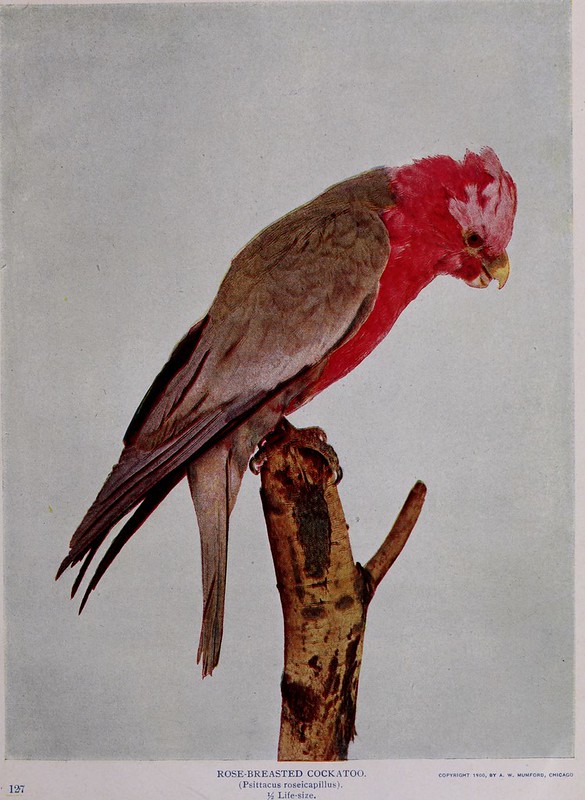
© Internet Archieve Book Images (Flickr)
The Rose-Breasted Cockatoo, also known as the Galah Cockatoo, is one of the world’s most popular, widespread, and unique cockatoos. This pink bird stands out with its beautiful yet distinct plumage. They’re often kept as pets because they have loveable and fun personalities.
These birds are native to Australia and can be found in open grasslands over much of the country. They travel in large flocks of mixed cockatoo species, such as sulfur-crested cockatoos. Additionally, they will mate with other species of cockatoos.
They’re a familiar sight in urban Australia due to a large part of their diet consisting of cultivated crops. In addition, they make use of livestock watering troughs and artificial ponds.
#4 Cassin’s Finch
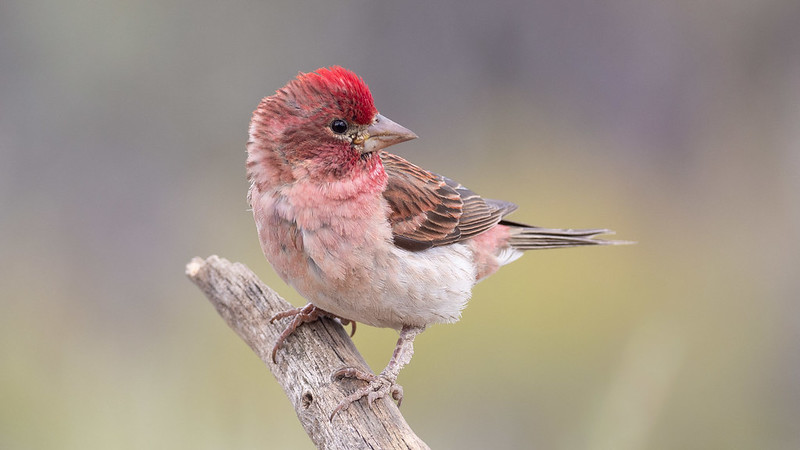
Cassin’s Finch. © David Renwald
The Cassin’s Finch is a small songbird with short-medium tails and peaked heads. They have heavy bills, notched tails, and long wings with tips that stick out past the tail. They’re about the same size as a House Finch and larger than a Pine Siskin.
Male Cassin’s Finches have intense red on their crowns and are rosy pink overall. Young birds and females are brown-and-white birds with clear, dark streaks on their underparts and chests. In addition, both males and females have streaks on their under-tail coverts and thin, white eyerings.
These birds are medium-distance migrants and residents. Most remain on their breeding grounds all year. However, some birds in the northern parts of their range move south in early fall or late summer. Some finches will move south into Mexico and return to their breeding grounds by May or April.
#3 Pink-headed Warbler
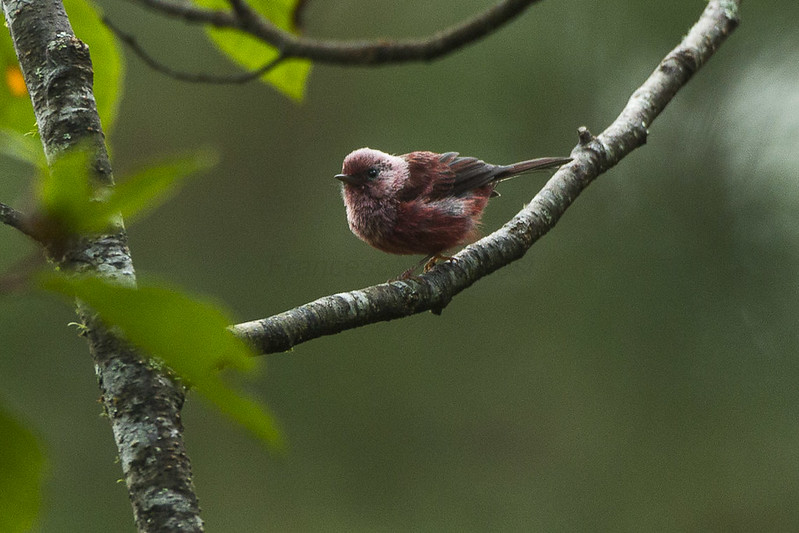
© Francesco Veronesi (Flickr)
The Pink-headed Warbler is a small bird found in the southeastern and central highlands of Chiapas and the southwestern highlands of Guatemala. It measures around 5 inches in length and weighs 0.35 ounces.
Both males and females look similar, though females are overall slightly duller. Adults are primarily red and have silvery-pink chests and heads. It is a common resident of semi-humid to humid pine-evergreen, pine-oak, and evergreen forests, at altitudes ranging from 1,800 to 3,500 meters above sea level.
It prefers to inhabit forests with undisturbed, dense understory. However, they can also be found in forests that have been disturbed and have damaged understory.
#2 Pink-headed Fruit Dove
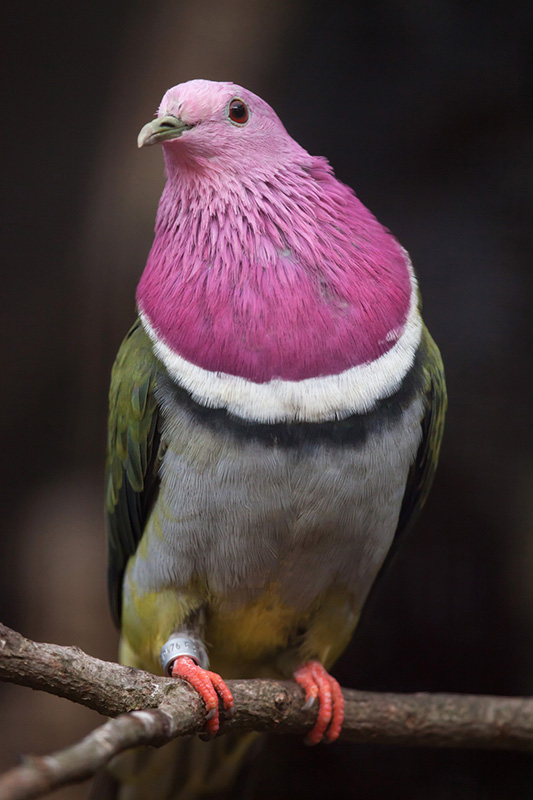
Pink-headed fruit dove
Pink-headed Fruit Doves are striking birds. These partially pink birds inhabit Indonesia in Bali, Java, and Sumatra mountain forests at altitudes of 1000 to 2200 meters. They’re an inconspicuous and shy species commonly seen by themselves or in pairs. However, flocks of these birds sometimes form at preferred fruit trees.
Male Pink-headed Fruit Doves have purplish-pink throats, necks, and heads that are bordered by a white band. This band is lined with greenish black. Their underparts are grey, their upper parts are green, and they have yellow undertail coverts.
Additionally, their feet are pink, and their bills are greenish. Females are duller overall than males and have a more delicate breast band.
#1 Pink Robin
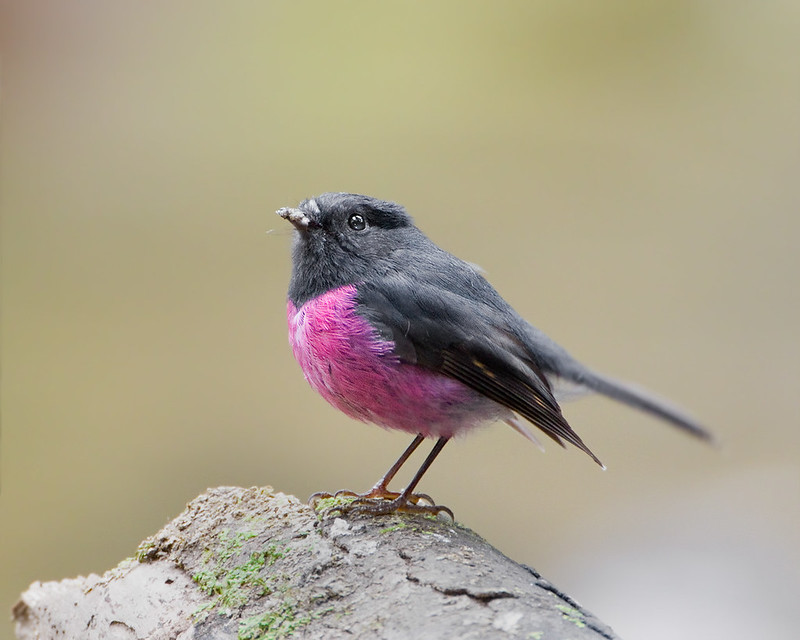
© JJ Harrison (Flickr)
The Pink Robin is a bird that’s often overlooked, even with its bright pink breast. They’re small, chunky birds that are quieter than other robins.
Male Pink Robins have black heads and throats and have brownish-black upper parts. Additionally, they have a small white spot just above their bill.
Females also have a spot above their bull, which is buff instead of white. Males have a pink wash on their breast that expands to the underbelly. Female Pink Robins have a pinkish tint, are olive-brown above, and have cinnamon-buff underparts.
These birds are native to southeastern Australia and prefer forests so that they can forage for food on the ground. They’ll primarily consume spiders and other insects
Did we miss something? Let us know in the comments!

